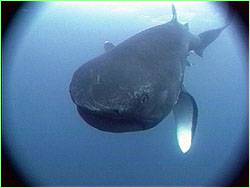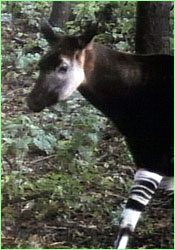
|
 |
 |
by Peter Tyson The first evidence that a fabled donkey-like creature existed in the heart of the Congo appeared in Henry Morton Stanley's 1860 book In Darkest Africa. Stanley wrote that the Wambutti pygmies, who lived in the Ituri forests, "knew a donkey and called it 'atti.' They say that they sometimes catch them in pits. What they can find to eat is a wonder. They eat leaves." But no one had ever heard of asses in the Congo. The only member of the horse family known from the region was the zebra, and zebras don't live in forests, especially the deep jungle where the pygmies hunted. Intrigued by Stanley's report, Sir Harry Johnston, then Governor of Uganda, questioned some pygmies he met in 1899. "They at once understood what I meant," he wrote, "and pointing to a zebra-skin and a live mule, they informed me that the creature in question . . . was like a mule with zebra stripes on it." When they showed him the elusive creature's cloven-footed tracks, Johnston changed his mind. "I disbelieved them," he wrote, "and imagined that we were merely following a forest-eland." (The eland is a large African antelope.) Finally, when he got hold of a skin, Johnston changed his mind yet again: "Upon receiving this skin, I saw at once what [it] was—namely, a close relation to the giraffe."
Could a more fantastical beast be imagined? Few Europeans believed it existed, but Johnston's persistence paid off. In the early part of this century, the animal finally became known to science as the okapi. Named for Johnston, Okapia johnstoni is a heavy-bodied animal with a coat of reddish chestnut, yellowish-white cheeks, and thighs ringed with alternating stripes of cream and purplish black. Johnston's last guess about this oddball creature was right—it is related to the giraffe. To bring to light a huge, unknown mammal in this century astounded the world. As one scientist has written, we today have no idea of "the romance surrounding the discovery of the Okapi, nor of the excitement caused in natural history circles, first by the vague reports of its presence, and later by its actual finding." Those who disbelieve in the Loch Ness monster and other fabulous creatures would do well to remember the okapi, as well as certain points surrounding its discovery. To wit:
Continue Fantastic Creatures | Birth of a Legend Eyewitness Accounts | Experimenting with Sonar Resources | Transcript | Site Map | Loch Ness Home Editor's Picks | Previous Sites | Join Us/E-mail | TV/Web Schedule About NOVA | Teachers | Site Map | Shop | Jobs | Search | To print PBS Online | NOVA Online | WGBH © | Updated November 2000 |
 Unknown creatures of great size and wonderment
continue to turn up, such as the "megamouth" shark,
which was first identified as recently as 1976.
Unknown creatures of great size and wonderment
continue to turn up, such as the "megamouth" shark,
which was first identified as recently as 1976.
 The antelope - donkey - anteater - giraffe, otherwise
known as the okapi.
The antelope - donkey - anteater - giraffe, otherwise
known as the okapi.
 For centuries savvy merchants sold narwhal tusks as
the horns of the fabled unicorn.
For centuries savvy merchants sold narwhal tusks as
the horns of the fabled unicorn.